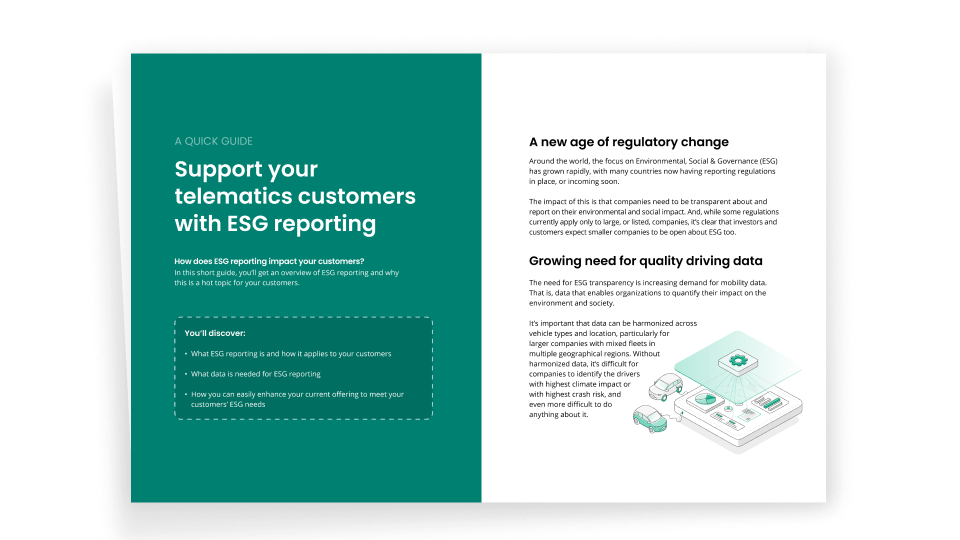How can I make my driving data more actionable?

Data plays a pivotal role in fleet management. But, to deliver true value, the data needs to be actionable. With actionable driving data, fleet managers can take greater control across operations, including risk management and sustainability.
In this blog article, I explain what is meant by “actionable driving data” and how you, as a telematics solution provider (TSPs) can ensure you provide the data your customers need.
What is actionable driving data?
Quite simply actionable driving data is data that can easily be actioned upon. To be “actionable”, driving data needs to be accurate, in context and made available to the people who need it so they can make informed decisions.
To bring the greatest value, actionable driving data makes it easy to see WHY it shows what it does, and WHAT can be done to improve results.
What type of actionable driving data do fleets need?
The amount of data required to operate a fleet successfully continues to grow. Vehicle tracking, maintenance and compliance are some examples of performance areas that require data. However, right now, safety and sustainability are certain to top the list of fleet priorities.
Globally, we’re seeing an increased focus on Environmental, Social and Governance (ESG) compliance, led by new and incoming ESG reporting regulations. The regulations require organizations to step up their transparency around social (driver safety) and environmental impact, leading to greater demand for data in these areas.
Your role in providing actionable driving data
As a trusted partner to your fleet customers, it’s highly likely that you’ll be the automatic choice to deliver actionable driving data for safety and sustainability management. That is, data that will help your customers to boost their risk mitigation efforts, increase transparency around their social and environmental impact, and help them fulfil ESG reporting requirements.
The question is, do you have the data they need? Here are five questions to help you determine whether you do.
1. Do you provide actionable driver safety data?
Consider the type of data your customers need to measure their drivers’ risk level – and, more importantly, act to mitigate high risk. Actionable driving data makes it easy for fleets to:
- See risk at a fleet and driver level
- Identify the drivers with highest and lowest crash risk
- See trends in data, such as days of week that risk is highest
- Benchmark by time, industry, country, world, etc.
- Recognize contributors to crash risk, to determine the areas in which training is required
- Predict crashes before they happen
2. Are fleets able to see their environmental impact?
Consider whether the data you provide helps your customers to measure the environmental impact of their transport operations. With actionable driving data, fleets can:
- Measure climate impact at a fleet and driver level
- See drivers with highest and lowest impact on emissions, regardless of vehicle type or location
- Quantify absolute CO2 emissions as well as avoided emissions through improved eco-driving
- Benchmark by time, industry, country, world, etc.
- Identify drivers for targeted eco-training
3. Is there a clear path to improvement?
As well as measuring risk and climate impact, actionable driving data enables your customers to see which drivers are most in need of training (whether it be safety or eco-training) AND provides a clear path to improvement.
It’s important for your customers to be able to see reasons for crash risk and environmental impact. This is particularly important in risk mitigation when there are sudden changes in risk level that need to be addressed as a priority.
4. Is the data harmonized?
You can provide all the data in the world, but if it’s not harmonized, it’s not truly actionable.
To understand this, let’s take an example of a fleet with mixed vehicle types. Your customer knows that the driver of a large truck will always have a higher overall climate impact than the driver of a small car. BUT, the driver of the car might have the least eco-friendly driving style. With harmonized driving data, your customer can identify the driver influence on CO2 emissions and determine which driver(s) will benefit most from training interventions.
5. Do you provide predictive data that supports a proactive approach to intervention?
Does the driving data you provide enable your customers to predict crashes before they happen so they can mitigate risk accordingly?
As discussed, actionable driving data is data that can be actioned. But, for optimized risk mitigation and sustainability management, consider when your customers want to act. The gold standard of actionable data enables your customers to act before a negative outcome occurs, not after.
To summarize, with truly actionable driving data, your fleet customers can measure their overall risk level and climate impact, identify drivers with the highest and lowest risk/climate impact, pinpoint where improvements need to be made, and act for improvement. With the right tools, they can also log action taken, follow-up on progress and evaluate the success of their interventions.
By providing this data to your fleet customers you’ll accelerate their driver risk and sustainability management efforts and simultaneously increase the stickiness of your own products with value-add solutions.


